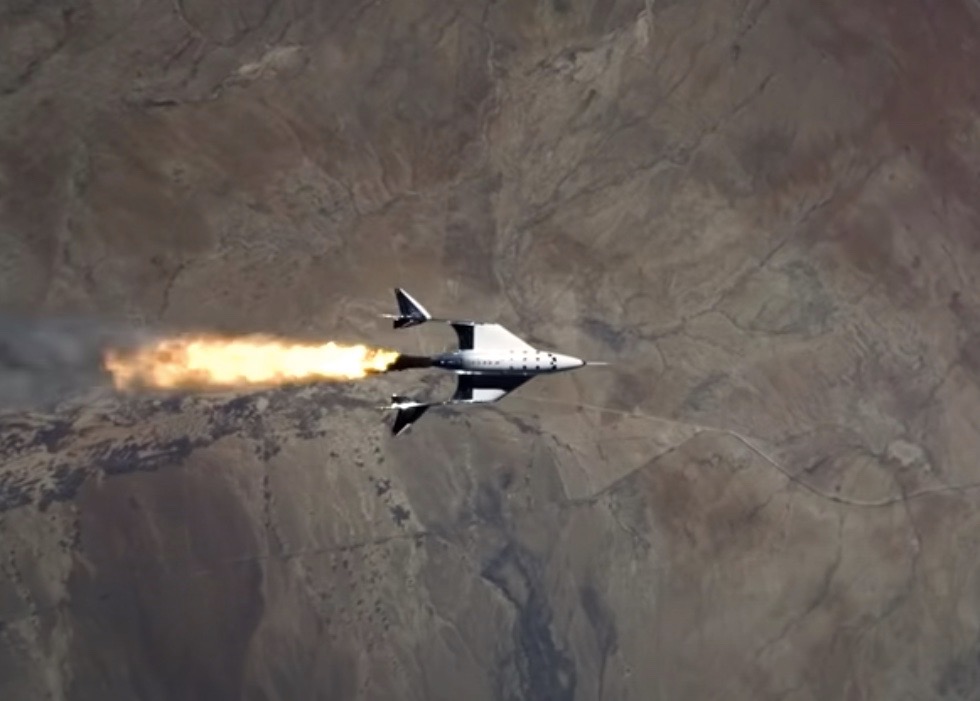Jeff Bezos' Blue Origin throws shade at Virgin Galactic ahead of Richard Branson's launch
The battle of which billionaire-backed space companies flies higher is on.

The battle of which billionaire-backed space company can fly higher is on.
As the suborbital spaceflight company Virgin Galactic counts down to the launch of its billionaire founder Richard Branson on Sunday (July 11), its biggest competitor Blue Origin, which will launch its own founder and billionaire Jeff Bezos on July 20, is ramping up its opposition marketing.
Blue Origin announced its launch date in May and auctioned off a ride to space from West Texas with Bezos for $28 million last month. On July 1, Virgin Galactic announced its own launch of Branson, three crewmates and two pilots. Their liftoff from the skies over New Mexico will be a full 9 days ahead of Blue Origin.
So it's no surprise if Blue Origin is a bit miffed to be beat.
Related: How to watch Virgin Galactic launch Richard Branson to space
More: How Virgin Galactic's SpaceShipTwo works (infographic)
On Twitter today (July 9), Blue Origin released an infographic taking swipes at the competition, focusing on matters such as the higher environmental impact of Virgin Galactic's Unity space plane, its smaller windows and lack of escape system. Blue Origin's New Shepard suborbital capsule has huge windows, creates water vapor exhaust and has an escape system. (This was despite Branson denying on the Today Show just days ago that he was jousting with Bezos: "I know nobody will believe me when I say it, but honestly, there isn't [competition]," he said.)
And then there's how high Virgin Galactic and Blue Origin can fly.
Breaking space news, the latest updates on rocket launches, skywatching events and more!
From the beginning, New Shepard was designed to fly above the Kármán line so none of our astronauts have an asterisk next to their name. For 96% of the world’s population, space begins 100 km up at the internationally recognized Kármán line. pic.twitter.com/QRoufBIrUJJuly 9, 2021
The key bone of contention for Blue Origin, however, appears to be the Kármán line, the internationally recognized boundary of space at 62 miles (100 kilometers) in altitude.
All of Virgin Galactic's spaceflights to date took place below that line, but well above another boundary of space at 50 miles (80 km) altitude recognized by the Federal Aviation Administration (FAA), NASA and the U.S. military.
"Only 4 percent of the world recognizes a lower limit of 80 km or 50 miles as the beginning of space," Blue Origin added in a Twitter comment with the infographic. "New Shepard flies above both boundaries. One of the many benefits of flying with Blue Origin."
Related: Richard Branson says he isn't racing Jeff Bezos into space with Virgin Galactic launch
Virgin Galactic's SpaceShipTwo is designed to launch two pilots and up to six passengers to suborbital space from a high altitude. It is carried into launch position by a carrier plane called VMS Eve. After reaching drop altitude, a SpaceShipTwo is released, launches into space and them returns to its homeport at Spaceport America outside of Las Cruces, New Mexico.
Blue Origin's New Shepard launches on a booster rocket of the same name, which then lands itself vertically after separating from the crew capsule. The capsule then flies to space and returns to Earth under a parachute. Blue Origin flights lift off from the company's West Texas launch site near Van Horn, Texas.
It's not the first time that Blue Origin has made such comments about the Kármán line. "We've always had as our mission that we wanted to fly above the Kármán line, because we didn't want there to be any asterisks next to your name about whether you're an astronaut or not," Bezos said in 2019. "That's something they [Virgin Galactic] are going to have to address, in my opinion."
Branson addressed the Kármán line dispute on Wednesday (July 7) during an interview with National Public Radio, repeating that both the FAA and NASA recognize the 50-mile boundary as the definition of astronauthood.
"The actual difference in experience is going to be almost non-existent," Branson told NPR, noting that passengers will get almost equal amounts of weightless time on Unity and New Shepard. (Unity is projected to have four minutes of weightlessness at the top of its suborbital curve, while New Shepard's is expected to be about three, according to Business Insider.)
While both companies hope to open to paying passengers soon, you will need deep pockets no matter which spaceflight option you choose. Virgin Galactic seats retail for a reported $250,000 each; everybody besides Branson on his flight will be Virgin Galactic employees.
New Shepard has not released seat pricing yet, but an as-yet-named auction winner paid the $28 million for the privilege of flying alongside Bezos, his brother Mark and Mercury 13 aviator Wally Funk, the latter of whom was apparently gifted the opportunity in recognition of the 82-year-old's long-standing service to aviation and space research.
Follow Elizabeth Howell on Twitter @howellspace. Follow us on Twitter @Spacedotcom and on Facebook.

Elizabeth Howell (she/her), Ph.D., was a staff writer in the spaceflight channel between 2022 and 2024 specializing in Canadian space news. She was contributing writer for Space.com for 10 years from 2012 to 2024. Elizabeth's reporting includes multiple exclusives with the White House, leading world coverage about a lost-and-found space tomato on the International Space Station, witnessing five human spaceflight launches on two continents, flying parabolic, working inside a spacesuit, and participating in a simulated Mars mission. Her latest book, "Why Am I Taller?" (ECW Press, 2022) is co-written with astronaut Dave Williams.

